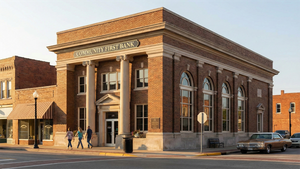Fabrice Marcolini, a curator, art historian, and former gallerist, has had a longstanding interest in the work of Canadian-born artist Jean-Paul Riopelle. Few names in Canadian art ring as true as Jean-Paul Riopelle’s. Fabrice Marcolini has spent the past two decades methodically compiling a collection of rare Riopelle artworks. This collection demonstrates Marcolini’s ongoing commitment to the legacy of one of Canada’s most admired artists. The goal of this piece is to demonstrate his novel approach to commemorating the centennial of an artist he has known and appreciated since the 1980’s.
Fabrice Marcolini first encountered Jean-Paul Riopelle’s work in person during a vacation in Canada in the early 1980s. At that time, there was renewed interest in Riopelle’s body of work, which is distinguished by its early explosive abstract expressionism and intricate mosaics of colors and shape, which laid the groundwork for a lifelong passion that evolved from admiration to a mission of preservation and repatriation.
Marcolini purchased his first original Riopelle painting from the 1950s from Gallery Dominion in Montreal, which featured the iconic mosaic background and foreground lines created with a stick immersed in paint and then allowed to drip over the canvas while upright on an easel. The work, titled “Bijoux Émietter,” was “discovered” in the reserve of that legendary gallery in the 1990s. This acquisition would subsequently be deaccessioned in the north to fuel others; it also acted as a catalyst for Marcolini’s greater goal, which was to commence consistent repatriation of the artist’s masterpieces scattered throughout Europe and the Americas.
Fabrice Marcolini has discovered and acquired several of Riopelle’s paintings, including significant pieces such as “Tramontane” (1954), “Couleur” (1955), and “Sphinx” (1956), for a private Canadian collection. His efforts have resulted in the return of numerous pieces of exceptional quality to private collections, as well as increased interest in Riopelle’s artwork internationally.
Fabrice is currently working on a project to place a collection of ten great Riopelle artworks to be donated thereof by an instantly minted patron of the Canadian arts.
The amounts are rumored north of $10 million, with further potential for appreciation given recent auction records and current strong demand.
Such a generous commitment would benefit the Musée Nationale des Beaux-Arts of Quebec, notably the Espace Riopelle Pavillion, which is now under development and will shortly open its doors in Quebec City. Riopelle’s legacy will be further strengthened in 2024, as well as abroad as a result of this endeavor.
Fabrice Marcolini’s commitment to Jean-Paul Riopelle’s oeuvre does not end with this centennial donation/celebration, which began with the opening of the Fondation Maeght retrospective in Saint-Paul de Vence in France and continued with the “Crossroad in Time” exhibition at the National Gallery of Canada in Ottawa, in October last year that just ended on April 2024, but will continue on as it a story of passion and profound appreciation for the transformative power Jean-Paul’s art, and Fabrice Marcolini’s journey with Riopelle’s artwork Is a history that is intertwined with the vision of a curator/gallerist who has dedicated his time and energy to preserving and celebrating this legacy. Marcolini’s efforts to secure a donor for the centenary celebration are a fitting tribute to an artist whose work has piqued the interest so far of a conspicuous group of international art collectors and patrons while the Pavilion Riopelle prepares imminently to open its doors.
Jean-Paul Riopelle, a Canadian painter and sculptor born on October 7, 1923, in Montreal, Quebec, died on March 12, 2002, in Ile-aux-Grues, near Quebec City, was widely regarded as Canada’s preeminent contemporary artist. His artistic output, primarily in the Abstract Expressionist genre, was frequently compared to that of Jackson Pollock, an American artist.
Riopelle moved to Paris in 1947 from Montreal. He became acquainted with Marcel Duchamp and André Breton, among other Surrealists, and had previously collaborated with Paul-Émile Borduas to form the Canadian automatist art collective Les Automatistes. He first gained international recognition in France. His early abstract and lyrical paintings evolved into a richer, more powerful impasto style. His extensive use of many mediums (such as chalk, ink, watercolor, and oils) and massive collage murals garnered him widespread praise. In 1954, he represented Canada at the Venice Biennale, when his enormous triptych Pavane earned him international fame.
Riopelle’s work was selected for the Venice Biennale again in 1962, and he was awarded the UNESCO Prize. In 1963, the National Gallery of Canada in Ottawa displayed 82 of Riopelle’s paintings and sculptures; at the age of 40, he became the youngest artist to have a retrospective show at such an institution. After spending most of his youth in Paris, he moved permanently to Quebec, Canada, in the early 1990s. During the latter decade of his life, he maintained a high pace of artistic output, and his creations grew increasingly figurative, with landscape themes incorporated into numerous paintings. L’Hommage à Rosa Luxemburg, his final major work, was completed in 2000. It was a narrative fresco made up of thirty paintings that extended over 40 meters (130 feet) in length.
Fabrice Marcolini was born in time for Expo 67 and grew up in Europe and Africa collecting personal art experience following the ever-growing cultural appetite of his Italian-French Canadian parents – he frequented art school in Italy and came back to Canada to enroll in Journalism school at Ryerson in 1988. After a couple of years as an arts and entertainment reporter, Fabrice Marcolini moved on to curate fine art exhibitions presented in most Italian Cultural institutes in North America as well as curated museum exhibitions in Europe, including “immaginario Inuit” at the Palazzo Forti in Verona. He subsequently founded Artcore Gallery in the late 90s in Toronto, presenting over 200 exhibitions in a decade within multiple spaces, and became an independent modern and contemporary art specialist in New York in 2010. Mr. Marcolini has since then helped a variety of collections worldwide acquire their most desired and prized artwork. Including works by Jeff Koons – Jean Michel Basquiat – Joseph Beuys – Alselm Kiefer – Gerard Richter – Jean-Paul Riopelle – Serge Poliakoff – Alberto Giacometti amongst others.
Read more investing news on PressReach.com.Subscribe to the PressReach RSS feeds:- Featured News RSS feed
- Investing News RSS feed
- Daily Press Releases RSS feed
- Trading Tips RSS feed
- Investing Videos RSS feed
Follow PressReach on Twitter
Follow PressReach on TikTok
Follow PressReach on Instagram
Subscribe to us on Youtube





